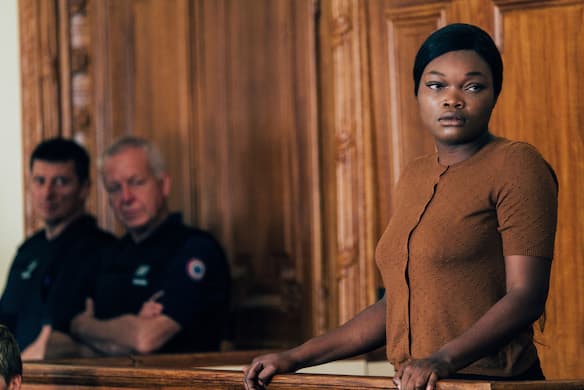While Flawed, ‘Saint Omer’ Offers Much That Is Worth Watching
The picture’s star performer, Guslagie Malanda, is setting herself up as a cultural impresario beyond just film, and it’ll be interesting to see how the director, Alice Diop, develops following her debut feature.

At the center of “Saint Omer,” the impressive, if sometimes frustrating, debut feature by Alice Diop, is a remarkable performance by Guslagie Malanda. Although Ms. Malanda appeared in an episode of “The Romanoffs,” the much-maligned Amazon series that bears serious reconsideration, and assayed the title role in “My Friend Victoria” (2014), she is, by no stretch of the imagination, a seasoned actress.
The visual arts are Ms. Malanda’s regular beat, with a degree in art history and significant curatorial ventures under her belt. She served as an adviser to the most recent iteration of the Venice Biennale, participated in workshops at the Berlin Biennale, and worked for the Bétonsalon Center for Art and Research in Paris. If Ms. Malanda does anywhere near as well in these pursuits as she does in “Saint Omer,” she’ll prove to be a cultural impresario worth keeping an eye on.
In “Saint Omer,” Ms. Malanda plays Laurence Coly, a woman accused of killing her 15-month-old daughter. Ms. Diop, who wrote the screenplay along with Amrita David and Marie Ndiaye, based her film on the true-to-life story of Fabienne Kabou, a 39-year old Senegalese woman who had emigrated to Paris to study philosophy and architecture. How coincidental the characters in “Saint Omer” are to actual persons, living or dead, can best be gleaned by the French reading public.
Ms. Malanda’s character may be the crux of “Saint Omer,” but she isn’t its sole focus. Kayije Kagama plays Rama, a professor of English and literature who gets caught up in the travails and the sensationalism of Laurence’s story. The audience learns, in passing, that Rama is working on a project involving the story of Medea. Later in the film we see her watching a vintage production of Euripedes’ play on YouTube. Subtlety isn’t always Ms. Diop’s forte.
When the trial opens in Saint Omer, a township situated in northern France, Rama packs her bags, leaves behind her partner, and becomes a permanent member of the courtroom. The judge overseeing the proceedings is unnamed, but her presence in “Saint Omer” is nothing short of intimidating. Valérie Dréville brings this judge to life with ferocious circumspection. Ms. Dréville, like Ms. Malanda, proves herself an actress worth reckoning with.
What draws Rama to Laurence is a shared heritage — though born in France, she, too, hails from Senegalese forebears — and, as we learn, impending motherhood. Through a series of intermittent flashbacks, we see the young Rama and her mother in circumstances and situations that portend a childhood marked more by aloofness than love. Between the court case, the past, and her future, is it any wonder Rama is as pensive as she is?
Here, again, there’s an uneasy elision between fact and fiction. Much in the way that Laurence is a thinly veiled version of Ms. Kabou, Rama is a stand-in for Ms. Diop, who underwent an “unspeakable obsession with this story.” Ms. Kabou’s trial, as reconfigured by a screenwriting team channeling the literature of antiquity, is a self-styled “political project that consists of connecting the stories of the women to the mythology that has never been offered to them.”
Audiences who aren’t inclined toward political grandstanding or, for that matter, condescension can be thankful that art is a stronger current here than ideology. Notwithstanding the closing argument by Laurence’s defense attorney — as egregiously tendentious a bit of screenwriting as you might fear — the majority of “Saint Omer” is fluid, hence unpredictable and provocative, in its assumptions about motherhood, motives, murder, and, in the end, rationalism.
Whether Ms. Diop will work out the kinks of her aesthetic will be interesting to see. In the meantime, she’s prompted performances of stately proportions, subtlety, and grit from Mmes. Malanda and Dréville. Those, alone, are worth a movie-goer’s time and money.

